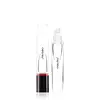What's inside
What's inside
 Key Ingredients
Key Ingredients

 Benefits
Benefits

 Concerns
Concerns

No concerns
 Ingredients Side-by-side
Ingredients Side-by-side

Simmondsia Chinensis Seed Oil
EmollientHydrogenated Polyisobutene
EmollientOctyldodecanol
EmollientEthylene/Propylene/Styrene Copolymer
Silica Dimethyl Silylate
EmollientCalcium Carbonate
AbrasiveCalcium Aluminum Borosilicate
Mica
Cosmetic ColorantPhenoxyethanol
PreservativeButylene/Ethylene/Styrene Copolymer
Pentaerythrityl Tetra-Di-T-Butyl Hydroxyhydrocinnamate
AntioxidantSilica
AbrasiveEthylhexylglycerin
Skin ConditioningAroma
CI 77891
Cosmetic ColorantTin Oxide
AbrasiveSimmondsia Chinensis Seed Oil, Hydrogenated Polyisobutene, Octyldodecanol, Ethylene/Propylene/Styrene Copolymer, Silica Dimethyl Silylate, Calcium Carbonate, Calcium Aluminum Borosilicate, Mica, Phenoxyethanol, Butylene/Ethylene/Styrene Copolymer, Pentaerythrityl Tetra-Di-T-Butyl Hydroxyhydrocinnamate, Silica, Ethylhexylglycerin, Aroma, CI 77891, Tin Oxide
Ingredients Explained
These ingredients are found in both products.
Ingredients higher up in an ingredient list are typically present in a larger amount.
Hydrogenated Polyisobutene is a synthetic polymer. Polymers are compounds with high molecular weight. Hydrogenated Polyisobutene is an emollient and texture enhancer.
In one study, Hydrogenated Polyisobutene showed better skin hydration levels than Caprylic/Capric Triglyceride. As an emollient, it helps keep your skin soft and hydrated by trapping moisture in.
Hydrogenated Polyisobutene is often used as a mineral oil replacement.
Learn more about Hydrogenated PolyisobuteneOctyldodecanol is a fatty alcohol. It is primarily used to enhance the texture of products.
As an emulsifier, Octyldodecanol helps prevent the oils and waters from separating. It also prevents ingredients from creating foam when shaken.
Octyldodecanol is created by reducing fatty acid to an alcohol.
Due to its high molecular weight, it does not get absorbed into the skin.
Learn more about OctyldodecanolPhenoxyethanol is a preservative that has germicide, antimicrobial, and aromatic properties. Studies show that phenoxyethanol can prevent microbial growth. By itself, it has a scent that is similar to that of a rose.
It's often used in formulations along with Caprylyl Glycol to preserve the shelf life of products.